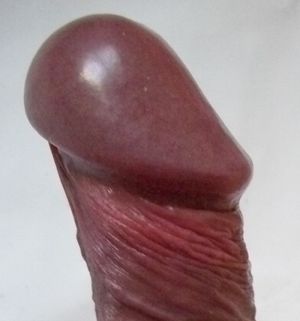Glans penis
In male human anatomy, the glans penis (or simply glans, /ɡlænz/)[1] is the sensitive bulbous structure at the distal end of the penis. The glans is anatomically homologous to the clitoral glans of the human female. Typically, the glans is completely or partially covered by the foreskin, except in men who have been circumcised, though the foreskin can generally be retracted over and past the glans.
The glans penis, or simply the glans, refers to the head of the penis. The glans is normally covered by a hood of folded skin called the foreskin. The foreskin moisturizes the glans penis by transudation. The surface of the glans is mucosal tissue that, under normal conditions, is moist and supple. If left uncovered for long periods of time, the surface of the glans becomes desiccated. In the circumcised penis, the glans is permanently exposed; the surface of the glans dries out and develops layers of keratin and loses sensation.
The glans penis receives much of its blood supply through the frenular artery.
First retraction of the foreskin
Functions of the foreskin include protecting the glans penis from abrasion and moistening it with body oils and moisture to keep it moist and sensitive.[1]
It is normal for the glans penis (head of the penis) to be very sensitive to touch when the foreskin is retracted for the first time since birth.
There is no particular reason to touch the head so, if it is sensitive to touch, then one may simply avoid touching it. Keeping the foreskin forward in its protective position over the glans penis also prevents pain.
Sensitivity and innervation of the glans penis
The human glans penis has virtually no fine touch sensation and can only sense deep pressure and pain at a high threshold. This was first reported by the inventor of the aesthesiometer, and led Sir Henry Head to make his famous comparison with the back of the heel.
The dartos muscle sheet in the foreskin produces contractions that are slow, sustained, and may produce great force, such as in cold temperatures.[2]
The innervation of the glans responds to pressure hence the glans are meant to be stimulated with the foreskin as its medium.
While the human glans penis is protopathic, the prepuce contains a high concentration of touch receptors in the ridged band.
In the human penis, the prepuce is known to have ten times more corpuscular sensory receptors than the glans penis.
Most people are surprised to learn that the glans penis is one of the least sensitive parts of the entire body.[3] The glans is insensitive to light touch, heat, cold, and even pinpricks, as researches at the Department of Pathology in the Health Science Centre at the University of Manitoba discovered[4] The corona of the glans contains scattered free nerve endings, genital end bulbs, and pacinian corpuscles, which transmit sensations of pain and deep pressure. The glans is nearly incapable of detecting light touch.
The results of a fascinating study conducted by Dr. Christopher J. Cold and Dr. Kenneth A. McGrath demonstrate that the human foreskin is an evolutionary advancement over the foreskins of other primates. The human foreskin is far more sophisticated and responsive, as their comparative anatomy studies prove. This is seen most clearly in the evolutionary increase in corpuscular innervation and simultaneous decrease in corpuscular receptors in the human glans relative to the innervation of the foreskin and glans of lower primates.[5]
In other words, in monkeys and apes, the glans is more sensitive then the foreskin. In humans, this is reversed, so that the foreskin is more sensitive then the glans.
An impressive study performed by objective Chinese researchers conclusively demonstrated that circumcision reduces the glans sensitivity to vibration.
"The test group were 1.97 +/- 0.71, 2.64 +/- 1.38, 3.09 +/-1.46 and 2.97 +/- 1.20 respectively before and 1, 2 and 3 months after circumcision, with significant difference between pre- and post-operation (P < 0.05)."(1) [6]
References
- ↑
 Fleiss P, Hodges F., Van Howe RS. Immunological functions of the human prepuce. Sex Trans Infect. October 1998; 74(5): 364-67. PMID. Retrieved 3 April 2020.
Fleiss P, Hodges F., Van Howe RS. Immunological functions of the human prepuce. Sex Trans Infect. October 1998; 74(5): 364-67. PMID. Retrieved 3 April 2020.
- ↑ Jefferson G. The peripenic muscle; some observations on the anatomy of phimosis. Surgery, Gynecology and Obstetrics 1916 Aug;23(2):177-81.
- ↑ Halata Z, Munger BL. The Neuroanatomical basis for the protopathic sensibility of the human glans penis. Brain Res 1986 Apr 23;371(2):205-30.
- ↑
 Taylor JR, Lockwood AP, Taylor AJ. The prepuce: specialized mucosa of the penis and its loss to circumcision. Br J Urol. 1996; 77: 291-5. PMID. DOI. Retrieved 23 September 2019.
Taylor JR, Lockwood AP, Taylor AJ. The prepuce: specialized mucosa of the penis and its loss to circumcision. Br J Urol. 1996; 77: 291-5. PMID. DOI. Retrieved 23 September 2019.
- ↑ Cold CJ, McGrath KA. Anatomy and histology of the penile and clitoral prepuce in primates: an evolutionary perspective of the specializes sensory tissue of the external genitalia. In: Denniston GC, Hodges MF, Milos FM (eds). Male and female circumcision: Medical, Legal, and Ethical Considerations in Pediatric Practice. New York: Kluwer Academic/Plenum Publishers, 1999. pp. 19-29
- ↑ Yang, D.-M., Lin, H., Zhang, B., & Guo, W. (2008). Circumcision affects glans penis vibration perception threshold. Zhonghua nan ke xue National Journal of Andrology, 14(4), 328-30. Retrieved 21 July 2021.

